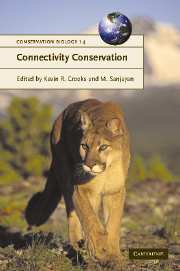Book contents
- Frontmatter
- Contents
- List of contributors
- Acknowledgements
- 1 Connectivity conservation: maintaining connections for nature
- PART I Approaches to connectivity research
- Introduction: Connectivity research—what are the issues?
- 2 Landscape connectivity: a return to the basics
- 3 Connectivity and metapopulation dynamics in highly fragmented landscapes
- 4 Genetics and landscape connectivity
- 5 Connectivity at the land–water interface
- 6 Influence of natural landscape fragmentation and resource availability on distribution and connectivity of gray wolves (Canis lupus) in the archipelago of coastal British Columbia, Canada
- 7 Migratory connectivity
- 8 Connectivity in marine ecosystems: the importance of larval and spore dispersal
- 9 Connectivity and wide-ranging species in the ocean
- 10 Hydrologic connectivity: a neglected dimension of conservation biology
- 11 Connectivity and ecosystem services: crop pollination in agricultural landscapes
- PART II Assessing connectivity
- PART III Challenges and implementation of connectivity conservation
- Index
- References
11 - Connectivity and ecosystem services: crop pollination in agricultural landscapes
Published online by Cambridge University Press: 24 May 2010
- Frontmatter
- Contents
- List of contributors
- Acknowledgements
- 1 Connectivity conservation: maintaining connections for nature
- PART I Approaches to connectivity research
- Introduction: Connectivity research—what are the issues?
- 2 Landscape connectivity: a return to the basics
- 3 Connectivity and metapopulation dynamics in highly fragmented landscapes
- 4 Genetics and landscape connectivity
- 5 Connectivity at the land–water interface
- 6 Influence of natural landscape fragmentation and resource availability on distribution and connectivity of gray wolves (Canis lupus) in the archipelago of coastal British Columbia, Canada
- 7 Migratory connectivity
- 8 Connectivity in marine ecosystems: the importance of larval and spore dispersal
- 9 Connectivity and wide-ranging species in the ocean
- 10 Hydrologic connectivity: a neglected dimension of conservation biology
- 11 Connectivity and ecosystem services: crop pollination in agricultural landscapes
- PART II Assessing connectivity
- PART III Challenges and implementation of connectivity conservation
- Index
- References
Summary
INTRODUCTION
As the focus of ecological research has broadened from site-level observations and experiments to landscape-scale studies, interest among ecologists in connectivity among habitat patches has increased (Turner et al. 1995; Wiens 1995; Gustafson and Gardner 1996; Hanski and Gilpin 1997; Haddad and Baum 1999). From a conservation perspective, concern with the maintenance of connectivity has grown as habitat loss and fragmentation continue worldwide (Rosenberg et al. 1997; de Lima and Gascon 1999; Haddad and Baum 1999). Typically, both basic and applied studies consider connectivity among patches of the same habitat type, such as a set of forest fragments embedded in a matrix of agricultural land uses. These studies, reviewed throughout this volume, focus on measuring patch isolation and examining the utility of corridors to restore connectivity among patches.
However, another type of connectivity, although less well studied and understood, is of equal importance in these complex landscapes: the connectivity among patches of different habitat types (Daily et al. 2001; Ricketts et al. 2001; Talley et al. Chapter 5). Many species require different habitat types for different resources or life-history stages. The proximity and availability of different habitat types, therefore, can affect the population dynamics and persistence of individual species and the diversity of communities. For example, bees often nest in one habitat type (e.g, tree cavities in forest) but require other types for forage (e.g., wildflower meadows).
- Type
- Chapter
- Information
- Connectivity Conservation , pp. 255 - 290Publisher: Cambridge University PressPrint publication year: 2006
References
- 11
- Cited by



